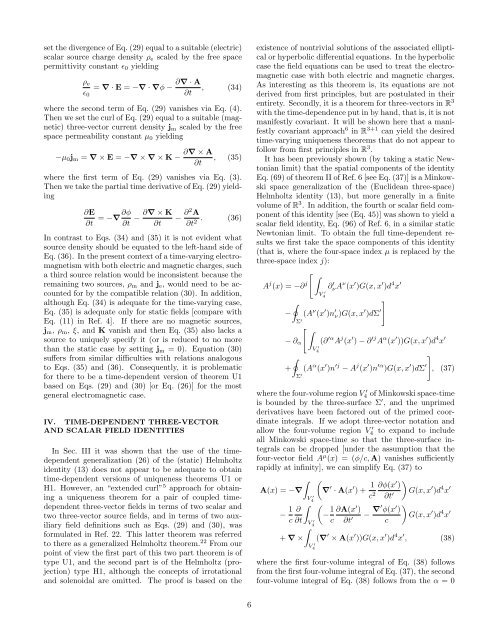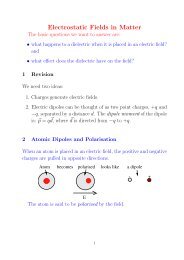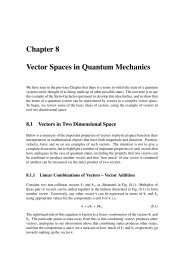Three-vector and scalar field identities and uniqueness theorems in ...
Three-vector and scalar field identities and uniqueness theorems in ...
Three-vector and scalar field identities and uniqueness theorems in ...
You also want an ePaper? Increase the reach of your titles
YUMPU automatically turns print PDFs into web optimized ePapers that Google loves.
set the divergence of Eq. (29) equal to a suitable (electric)<strong>scalar</strong> source charge density ρ e scaled by the free spacepermittivity constant ɛ 0 yield<strong>in</strong>gρ e= ∇ · E = −∇ · ∇φ − ∂∇ · A , (34)ɛ 0 ∂twhere the second term of Eq. (29) vanishes via Eq. (4).Then we set the curl of Eq. (29) equal to a suitable (magnetic)three-<strong>vector</strong> current density j m scaled by the freespace permeability constant µ 0 yield<strong>in</strong>g−µ 0 j m = ∇ × E = −∇ × ∇ × K − ∂∇ × A , (35)∂twhere the first term of Eq. (29) vanishes via Eq. (3).Then we take the partial time derivative of Eq. (29) yield<strong>in</strong>g∂E∂t = −∇∂φ ∂t − ∂∇ × K − ∂2 A∂t ∂t 2 . (36)In contrast to Eqs. (34) <strong>and</strong> (35) it is not evident whatsource density should be equated to the left-h<strong>and</strong> side ofEq. (36). In the present context of a time-vary<strong>in</strong>g electromagnetismwith both electric <strong>and</strong> magnetic charges, sucha third source relation would be <strong>in</strong>consistent because therema<strong>in</strong><strong>in</strong>g two sources, ρ m <strong>and</strong> j e , would need to be accountedfor by the compatible relation (30). In addition,although Eq. (34) is adequate for the time-vary<strong>in</strong>g case,Eq. (35) is adequate only for static <strong>field</strong>s [compare withEq. (11) <strong>in</strong> Ref. 4]. If there are no magnetic sources,j m , ρ m , ξ, <strong>and</strong> K vanish <strong>and</strong> then Eq. (35) also lacks asource to uniquely specify it (or is reduced to no morethan the static case by sett<strong>in</strong>g j m = 0). Equation (30)suffers from similar difficulties with relations analogousto Eqs. (35) <strong>and</strong> (36). Consequently, it is problematicfor there to be a time-dependent version of theorem U1based on Eqs. (29) <strong>and</strong> (30) [or Eq. (26)] for the mostgeneral electromagnetic case.IV. TIME-DEPENDENT THREE-VECTORAND SCALAR FIELD IDENTITIESIn Sec. III it was shown that the use of the timedependentgeneralization (26) of the (static) Helmholtzidentity (13) does not appear to be adequate to obta<strong>in</strong>time-dependent versions of <strong>uniqueness</strong> <strong>theorems</strong> U1 orH1. However, an “extended curl” 5 approach for obta<strong>in</strong><strong>in</strong>ga <strong>uniqueness</strong> theorem for a pair of coupled timedependentthree-<strong>vector</strong> <strong>field</strong>s <strong>in</strong> terms of two <strong>scalar</strong> <strong>and</strong>two three-<strong>vector</strong> source <strong>field</strong>s, <strong>and</strong> <strong>in</strong> terms of two auxiliary<strong>field</strong> def<strong>in</strong>itions such as Eqs. (29) <strong>and</strong> (30), wasformulated <strong>in</strong> Ref. 22. This latter theorem was referredto there as a generalized Helmholtz theorem. 22 From ourpo<strong>in</strong>t of view the first part of this two part theorem is oftype U1, <strong>and</strong> the second part is of the Helmholtz (projection)type H1, although the concepts of irrotational<strong>and</strong> solenoidal are omitted. The proof is based on theexistence of nontrivial solutions of the associated ellipticalor hyperbolic differential equations. In the hyperboliccase the <strong>field</strong> equations can be used to treat the electromagneticcase with both electric <strong>and</strong> magnetic charges.As <strong>in</strong>terest<strong>in</strong>g as this theorem is, its equations are notderived from first pr<strong>in</strong>ciples, but are postulated <strong>in</strong> theirentirety. Secondly, it is a theorem for three-<strong>vector</strong>s <strong>in</strong> R 3with the time-dependence put <strong>in</strong> by h<strong>and</strong>, that is, it is notmanifestly covariant. It will be shown here that a manifestlycovariant approach 6 <strong>in</strong> R 3+1 can yield the desiredtime-vary<strong>in</strong>g <strong>uniqueness</strong> <strong>theorems</strong> that do not appear tofollow from first pr<strong>in</strong>ciples <strong>in</strong> R 3 .It has been previously shown (by tak<strong>in</strong>g a static Newtonianlimit) that the spatial components of the identityEq. (69) of theorem II of Ref. 6 [see Eq. (37)] is a M<strong>in</strong>kowskispace generalization of the (Euclidean three-space)Helmholtz identity (13), but more generally <strong>in</strong> a f<strong>in</strong>itevolume of R 3 . In addition, the fourth or <strong>scalar</strong> <strong>field</strong> componentof this identity [see (Eq. 45)] was shown to yield a<strong>scalar</strong> <strong>field</strong> identity, Eq. (96) of Ref. 6, <strong>in</strong> a similar staticNewtonian limit. To obta<strong>in</strong> the full time-dependent resultswe first take the space components of this identity(that is, where the four-space <strong>in</strong>dex µ is replaced by thethree-space <strong>in</strong>dex j):[ ∫A j (x) = −∂ j ∂ νA ′ ν (x ′ )G(x, x ′ )d 4 x ′V 4′](A∮Σ ν (x ′ )n ′ ν)G(x, x ′ )dΣ ′′−[ ∫− ∂ α (∂ ′α A j (x ′ ) − ∂ ′j A α (x ′ ))G(x, x ′ )d 4 x ′V 4′]+ (A∮Σ α (x ′ )n ′j − A j (x ′ )n ′α )G(x, x ′ )dΣ ′ , (37)′where the four-volume region V 4 ′ of M<strong>in</strong>kowski space-timeis bounded by the three-surface Σ ′ , <strong>and</strong> the unprimedderivatives have been factored out of the primed coord<strong>in</strong>ate<strong>in</strong>tegrals. If we adopt three-<strong>vector</strong> notation <strong>and</strong>allow the four-volume region V 4 ′ to exp<strong>and</strong> to <strong>in</strong>cludeall M<strong>in</strong>kowski space-time so that the three-surface <strong>in</strong>tegralscan be dropped [under the assumption that thefour-<strong>vector</strong> <strong>field</strong> A µ (x) = (φ/c, A) vanishes sufficientlyrapidly at <strong>in</strong>f<strong>in</strong>ity], we can simplify Eq. (37) to∫A(x) = −∇− 1 ∫∂c ∂t∫+ ∇ ×V 4′V 4′V ′4(∇ ′ · A(x ′ ) + 1 ∂φ(x ′ ))c 2 ∂t ′(− 1 ∂A(x ′ )c ∂t ′ − ∇′ φ(x ′ )cG(x, x ′ )d 4 x ′)G(x, x ′ )d 4 x ′(∇ ′ × A(x ′ ))G(x, x ′ )d 4 x ′ , (38)where the first four-volume <strong>in</strong>tegral of Eq. (38) followsfrom the first four-volume <strong>in</strong>tegral of Eq. (37), the secondfour-volume <strong>in</strong>tegral of Eq. (38) follows from the α = 06
















